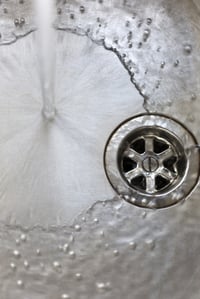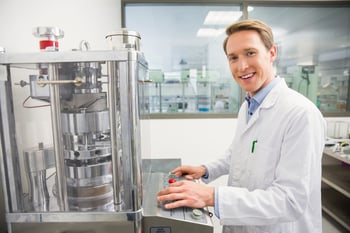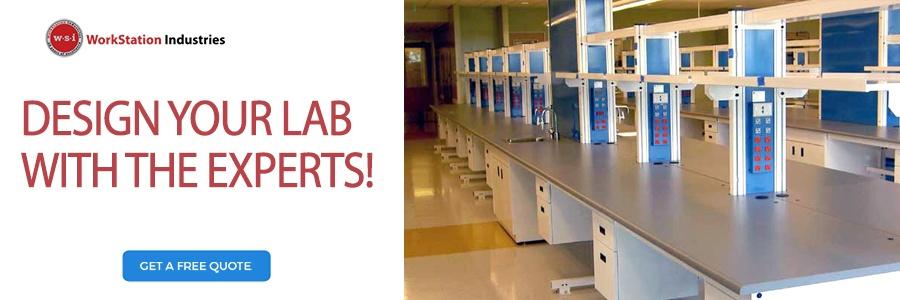Not all laboratories are alike. Some have basic requirements. Some have Electro Static Dissipative (ESD) requirements. Some have clean room requirements.
And, still other laboratories require sterilization processes or microbial protection for the work they do. These labs call for specialized laboratory furniture.
In these lab environments, stainless steel cabinets and furniture are the “go to” option.
Why? Because stainless steel has unique properties that make it a perfect fit.
Let’s look at the top 6 benefits:
1. Bacterial and Fungal Resistance
Stainless steel provides non-porous laboratory work surfaces, so that no liquids, bacteria, fungus or mold can penetrate it. This means that bacteria, fungi, and dirt have nowhere to hide.
With routine sanitation practices, the risk of germs spreading or cross contamination occurring is significantly reduced.

2. Moisture Resistance
Stainless steel is made of low carbon steel that consists of chromium and nickel. Chromium makes it resistant to rust and corrosion.
Because rust isn’t an issue, moisture is not an issue. This means that stainless steel is perfect for wet labs, sinks and intense liquid-based sterilization processes.
3. Chemical Resistance
Stainless steel has significant chemical resistance. Most salts, organic chemicals, solvents and biological stains are not an issue. Some acids and bases are also not an issue.
A few harsh acids (acetic acid, phosphoric acid, sulfuric acid) and bases (sodium hydroxide) are not recommended for use with stainless steel.
4. Heat Resistance
Nickel in stainless steel makes it heat resistant. It can sustain continuous heat exposure above 1500 °F. There may be some discolor with prolonged high temperatures, but “it can take the heat”.
This means stainless steel is a great fit for labs that use equipment with open flames, such as bunsen burners.
5. Durability
Stainless steel’s metal composition makes it highly impact resistant. In labs, there is usually a lot of movement of tools and equipment. While stainless steel can be dented, it is very difficult to puncture, so you don’t need to worry about piercing the clear coat finish (wood) or chipping paint (metal). You can learn about Steel vs. Wood in our previous article.
And, while it isn’t scratch resistant, it does maintain its aesthetic beauty over a long period of time.
6. Sustainability
Stainless steel is a recyclable material. The main alloying elements of stainless steel (chromium, nickel and molybdenum) are all highly valuable and can be easily be recovered and separated from other materials.
Today, where environmental issues are so important in saving and preserving our world, stainless steel is cleaner for the environment.
Other Advantages
If you’re not yet convinced of the many benefits that stainless steel cabinets provide, here are some of the other advantages they can provide your workspace.
 Aesthetic Appearance
Aesthetic Appearance
Stainless steel cabinets offer a sleek, modern look to any workspace. Because they are easy to clean and maintain, they can keep that shiny look with a simple all purpose cleaner and quick polish.
Stainless steel also includes an invisible layer of chromium oxide. This protects the stainless steel material from stains and corrosion, allowing the material to retain its sleek, new appearance.
It’s no surprise that because of the high-end look that stainless steel provides, it is one of the most popular materials in homes and several types of work environments.
Ease Of Fabrication
Stainless steel can be welded, bent, cut and fabricated as easily as other types of steels. This makes it the perfect material not only for cabinets, but for additional industrial steel workbench parts as well, including plates, bars and tubing.
Make sure you work with a distributor that receives its products from manufacturers that have the most up-to-date equipment. New top-of-the-line machinery makes it possible to cut, weld and bend stainless steel to create customized casework for your workspace.
Strength To Weight Advantage
The strength to weight advantage that stainless steel provides is one of the most overlooked benefits of this material. High strength duplex grades offer added strength, yet they also offer a reduction in the thickness of the material.
Choosing duplex grades provides a cost savings over choosing conventional grades because the cold hardening properties of the duplex grades reduce material thickness.
Long-Term Value
Because stainless steel is resistant to bacteria, fungus, moisture, chemicals and heat, there is great long-term value in using the material in your workspace. However, there are additional reasons why stainless steel will continue to offer value in the future.
Stainless steel has a unique ability that sets it apart from other materials … it can heal itself. The chromium in stainless steel forms an invisible chromium oxide film. When stainless steel is damaged, it may become exposed to oxygen. If this occurs, stainless steel will self heal itself. This means it once again regains its resistance to corrosion if exposed again.
For environmentally-conscious companies that base their purchasing decisions on the long-term impact they will have on the environment, it’s important to note that once stainless steel goes past its original purpose and is no longer needed, it can be recycled.
Because stainless steel can cost more than other materials when used in industrial applications, it’s important to consider how this cost impacts its long-term value as well. When the total life cycle of stainless steel is considered, it can be one of the least expensive choices if properly maintained. Stainless steel is both durable and resistant to many of the harsh conditions found in laboratories today, making it a great choice for your workspace now and in the future.
Lab equipment and furniture is an important investment, so it is important to know what product is right for your particular lab application. With the right choice, your lab furniture will be functional, durable and stand the test of time.



